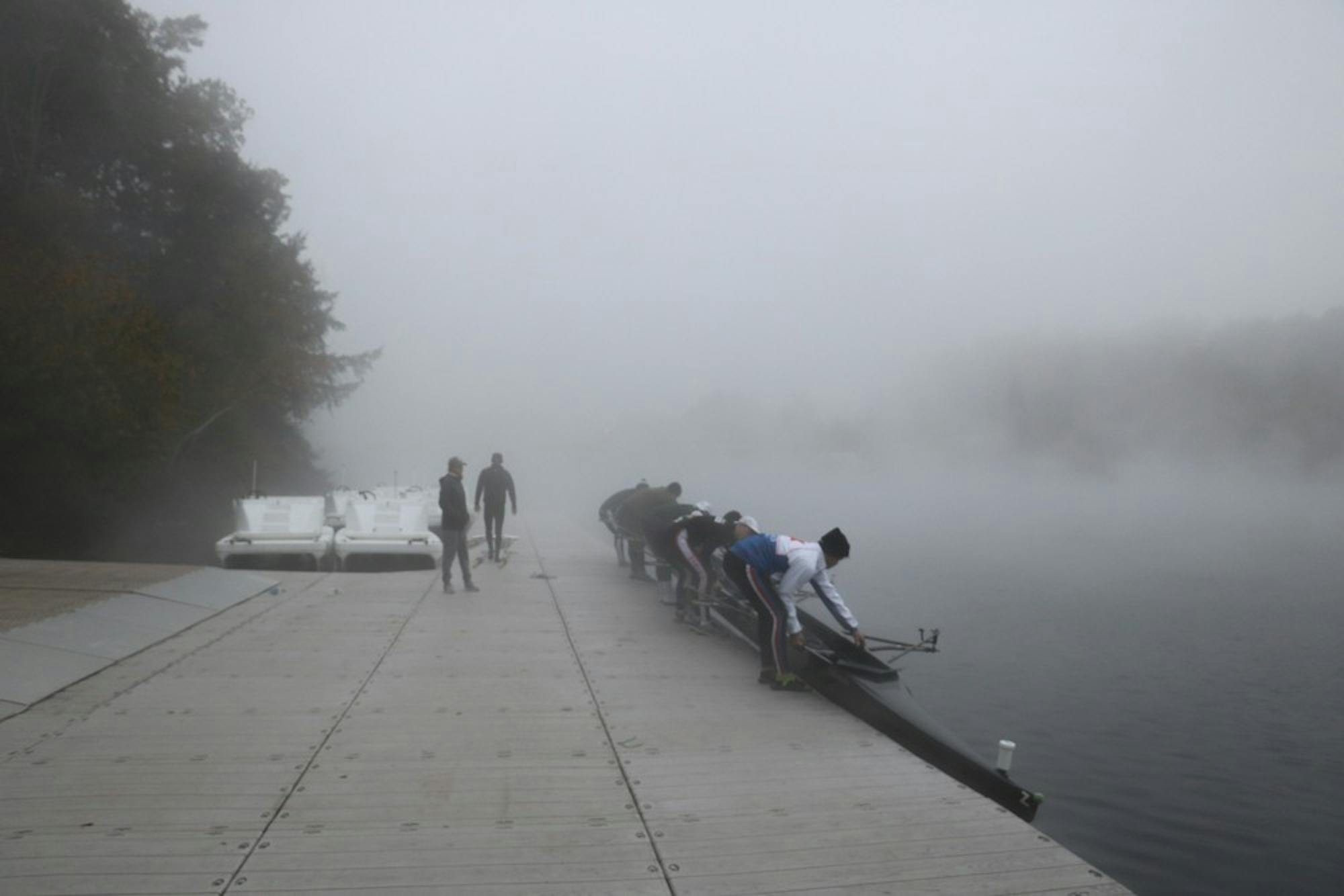While many fall sports are entering the final stretch of their regular seasons, the men’s heavyweight and lightweight rowers are putting in hours on the Connecticut River in preparation for their first races of the year. Seat selection has been ongoing ahead of the two big regattas of the fall: the Head of the Charles and the Princeton Chase.
Seat selection is a series of tests to see which athletes will represent the team in the first varsity boat. A soccer team has its starting 11, the combination of athletes which — in the eyes of the coaches — work together to create the best results. Rowing works the same way.
The testing occurs over the span of about 10 days and includes a fitness test on the ergometer and multiple seat races wherein rowers compete directly for spots. In a seat race, the coach races a boat, switches a pair of athletes and races it again.
Like most starting lineups, nothing is set in stone.
Lightweight rower Wyatt Genasci Smith ’19 knows this firsthand. He suffered a stress fracture in one of his ribs during the spring season.
“If someone in one of the higher boats gets injured, everyone gets bumped up from the boat behind them, so it’s perfectly possible for the combinations to change,” he said. "I wasn't able to compete in Nationals last season, so the guy who I had just beaten in my seat race for the spot just took my spot."
A team’s approach to seat selection depends largely on the philosophy of its coaches.
The heavyweight team’s coaching staff emphasizes power. Head coach Wyatt Allen ultimately wants to have the eight fastest rowers on the erg be his eight fastest rowers on the water.
“[Allen] will try to develop the stronger guys into boat movers, because ultimately you can’t win races in our league by just rowing well,” said former team member Scott Ortlip ’17, who rowed in the three seat of the varsity eight during the 2016-17 season.
The lightweight team’s process is less about strength.
“The fitness test won’t necessarily determine who will be in the Varsity,” Genasci Smith said. “A big part of the sport is technique and being able to move in the water.”
The selection process begins early in the season. Coaches put the fittest rowers and the best technical rowers into different combinations to see if any combination rows particularly well together. From there, the coaches make preliminary lineups and start seat racing.
“It’s not a perfect science,” men’s lightweight assistant coach Trevor Michelson said. “People get tired, people aren’t consistent but it’s really good to race each other all the time with something on the line. So when we go out there to race for real, it’s not the first time we’re racing.”
Ortlip says that seat racing gives the athletes the opportunity to earn their place in a higher boat. However, it is up to the coach to decide who has earned the opportunity to seat race another athlete. According to Ortlip, a rower can set themselves apart through erg testing or by consistently demonstrating superior technique.
The stakes of seat racing can be high. On the heavyweight team, some athletes get just one opportunity all season to prove themselves in a seat race.
“This system is rough and imperfect, but in a 10-week spring season, time settling into consistent lineups is at a premium, so sometimes the coach has to make judgment calls from everything he has observed all season and often as little as one seat race,” Ortlip said.
But even on the heavyweight team, each year is a fresh start for each athlete. A rower who was in the varsity eight last year has no advantage over a rower who was not.
On the lightweight team, the racing lineup can change from race to race.
“We’re a really close-knit group in terms of speed, so it’s been difficult from a coaching perspective to pick a top eight,” Michelson said. “That probably means that it definitely can change a lot with the winter training coming up.”
Genasci Smith and Ortlip said the upward pressure of testing drives the performance of the heavyweight and lightweight teams.
“The guy in the boat below you wants your seat, and you want the seat of the guy in the boat above you,” Ortlip said. “Therefore, everyone is always trying to outwork the guys above and below them so they can rise to a higher boat, or keep from getting picked off by someone who used to be slower than you. This drives everyone to be better, all the way from stroke seat of the [first varsity] down to three seat of the [fourth varsity].”
Allen and associate head coach for men’s heavyweight Al Monte emphasized the importance of every athlete in the program, according to Ortlip.
“While the guys in the [fourth varsity] aren’t racing for the cup in the dual races or championships, they put the pressure on everyone above them and thus the whole team becomes better,” Ortlip said. “It’s a really healthy dynamic that fosters a huge amount of development and speed.”
Seat racing can be fiercely competitive, but in the experience of Ortlip and Genasci Smith, hard feelings don’t last past the dock — and often don’t form in the first place.
Genasci Smith said seat selection builds a deeper and stronger program. The team remains close regardless of the result of any individual race. Genasci Smith lost a seat race hours before our interview.
“[My opponent is] still one of my best friends,” Genasci Smith said. “This means that I need to work harder. We have a very healthy dynamic on the team that fosters growth, development and improvement.”




